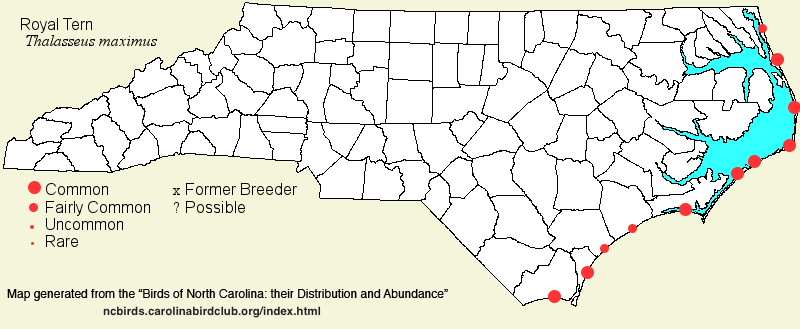 |  |
|
Royal Tern - Thalasseus maximus LARIDAE Members: | Search Common: Search Scientific: |
|
|
|||||||
| General Comments | The Royal Tern is the common large tern along the coast of the state for most of the year; however, relatively few remain in winter. Even so, only it and the Forster's Tern remain in winter over most of the coast. Though it looks quite similar to the slightly larger Caspian Tern, it is most closely related to the Sandwich Tern, and the latter species always breeds in colonies with the more common Royal Tern. Because the Royal Tern is strictly coastal throughout its range, far inland occurrences are almost always a result of being carried inland by hurricanes and tropical storms; however, it has been noted but once in the mountains. Royals shun freshwater ponds and impoundments for foraging, but they forage over the open ocean, along coasts, in inlets, and less so in sounds. Large numbers can be seen resting on sand flats, often with gulls. | ||||||
| Breeding Status | Breeder | ||||||
| NC BRC List | Definitive | ||||||
| State Status | |||||||
| U.S. Status | |||||||
| State Rank | S4B,S4N | ||||||
| Global Rank | G5 | ||||||
| Coastal Plain | Permanent resident (breeding), with migratory movements, along the coast. Common to very common along the entire coast in summer and during migrations; in winter, fairly common along the southern coast, but uncommon farther northward; can be scarce during severe weather periods in winter. In the Tidewater zone, fairly common during the warmer months, but uncommon in winter, and typically quite rare in midwinter. It breeds on small coastal islands, both natural and man-made, but not on barrier islands. Farther inland, very rare and local, only in late summer and fall (after hurricanes); all records from mid-Jul to late Sep, with a majority from the Goldsboro area. Peak counts: 6000, estimated on a spoil island in Pamlico Sound west of Oregon Inlet (Dare), 1 Jul 2019. Peak inland counts: 115, Buckhorn Reservoir (Wilson), 15 Sep 2018 (after Hurricane Florence). | ||||||
| Piedmont | Essentially only a storm-related visitor, in late summer and fall, to lakes and reservoirs. Very rare, from mid-Aug to early Oct, with a few records as early as late Jun. One photographed in flight at Carolina Lake (Rockingham) on 25 Jul 2022 was exceptional for a non-storm related individual. Peak counts: 120, Jordan Lake, 6-7 Sep 1996 (after Hurricane Fran); 41, Harris Lake (Wake), 15 Sep 2018 (after Hurricane Florence); 25, Falls Lake, 15 Sep 2018 (after Hurricane Florence); 15, Falls Lake, 6-7 Sep 1996 (after Hurricane Fran). | ||||||
| Mountains | Accidental/casual: one record. Three were photographed at Glenville Lake (Jackson) on 27 Sep 2024, following Hurricane Helene. | ||||||
| Finding Tips |
Easily found along the coast from Mar to Nov, but less so in winter. **** | ||||||
| Attribution | LeGrand[2025-01-30], LeGrand[2023-03-14], LeGrand[2022-12-22] | ||||||
| NC Map Map depicts all counties with a report (transient or resident) for the species. | Click on county for list of all known species. |
| NC Breeding Season Map Map depicts assumed breeding season abundance for the species. |  |